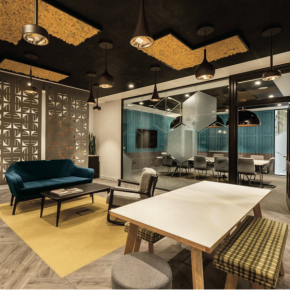
Agile solutions for businesses with glass partitioning
While solid walls can present barriers, glass partitioning remains a firm favourite of those looking to create light interiors that maximise square footage, offer privacy and sound insulation where needed.
Rachel Sullivan, category manager for ceilings and partitioning at CCF, explains why agile solutions of this kind have the potential to grow with the changing needs of businesses, buildings and their occupants, in the latest issue of ABC+D magazine.
With open-plan and flexible workspaces still very much in demand, architects, builders, contractors and developers are constantly being challenged by clients to design and deliver interior solutions that will stand the test of time.
While the creation of such spaces is not a new concept, successfully maximising the square footage of a building at the same time as meeting the needs of the people working in it warrants careful planning that takes both current requirements and future demands into account.
Glass is increasingly being introduced to achieve the right balance of accessibility and privacy, adding space and light to office environments. This material has a long history of use, going back further than 60 years when large sheets of frameless glazing were first introduced into workspaces.
Over the last decade, the market has changed and, certainly since the last recession, people are now looking for ways in which to make their workspaces more agile – a word that is proving quite popular in design circles right now.
Reasons behind this include the fact that business owners often want to be able to change their working spaces fairly quickly to suit the needs of their organisation – whether they are growing or downsizing. The need for a fresh corporate identity can also be a key driver of change and having a more standardised layout along with appropriate furniture can be closely tied to brand identity and creating the right image.
As well as getting the layout of individual offices right, there is a noticeable trend towards organisations introducing more modern ways to conduct meetings too, which again has implications for partitioning.
Rather than having a standard meeting room with a boardroom table, the development of more informal areas is one way for employers to make better use of space and get the most from their offices.
This is in part driven by people looking for new ways in which to encourage colleagues to interact with each other and work more efficiently together without having to restrict them to individual offices.
While open-plan working has lots of plus points, it is fair to say that the levels of accessibility and visibility that come with this mean people are realising they need private spaces in which to concentrate during the course of the day too. This could be to work on confidential matters or simply to focus when reading and writing.
Returning to the issue of agile working, while glass can be used to divide space and offer privacy, the fact that it allows so much visibility in an office environment is important. While managers may require a private office this doesn’t necessarily mean they want to be shut away from their colleagues behind a plasterboard wall and a closed door.
Being able to be seen through the office walls and being able to see into the environment beyond means they can maintain a connection with employees but have peace and quiet when they need it most.
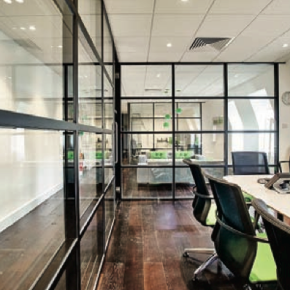
Glass is increasingly being introduced to achieve the right balance of accessibility and privacy, adding space and light to office environments – Rachel Sullivan CCF
Partitioning products can also be used to good effect when temporary zones or meeting rooms are needed from time to time for teams working on specific projects.
In these instances people are looking for products that are as flexible as possible, which can be put up, taken down and re-used elsewhere in the building; it’s all about maximising the return on investment. It is therefore the job of manufacturers to get inside the mind of the customer and develop the products that offer the greatest flexibility from both a layout and performance point of view.
While looks are important, acoustics and fire protection credentials are not to be overlooked. Recent developments in glass technology, for example, mean offices can now be constructed that are capable of reducing sound to the level of 50db.
Such increased performance comes at a cost though and the relationship between the different products being installed has to be taken into account as well.
Getting it right means paying particular attention, not only to the type of partitioning selected, but to where the partitioning meets the ceiling, floor and often the outside walls. Everything has to work together in harmony.
With this in mind, getting the installation right is absolutely essential. Even the best partitioning solution in the world could present problems if fitted incorrectly. It is therefore vital that products are installed by individuals who have been trained to carry out the work to a high standard and in accordance with the recommended method.
A poorly fitted solution can significantly reduce performance, so getting advice from manufacturers in the early stages will have a positive effect further down the line.
Just like architects and designers, many manufacturers are focused on the development of new products that are capable of pushing the boundaries of what is possible in interior design solutions.
While it is often not possible for every specifier to keep up with the latest materials, establishing a relationship with manufacturers and suppliers at the start of a project makes perfect sense and can result in a win-win situation for all involved.
Latest news
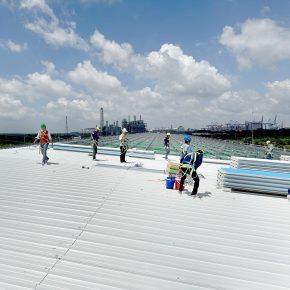
15th April 2024
EJOT Colorfast chosen for Kingspan’s highly sustainable new Asian factory
More than 120,000 EJOT Colorfast self-drilling fasteners have helped Kingspan to create a thermally superior, visually-appealing building envelope for its first purpose-built manufacturing plant in South East Asia.
Posted in Articles, Building Industry News, Building Products & Structures, Building Systems, Case Studies, Posts, Restoration & Refurbishment, Retrofit & Renovation, Roofs, Sustainability & Energy Efficiency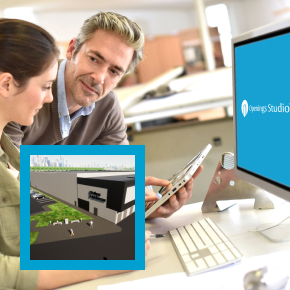
15th April 2024
ASSA ABLOY helps new manufacturing plant achieve LEED Gold certification
Improving sustainability performance is becoming a higher priority for building developers, owners and users. One consequence is fast-growing demand for green building certifications — and therefore specification. Specialist input can make the difference between hitting and missing a project target, as ASSA ABLOY explains here…
Posted in Access Control & Door Entry Systems, Architectural Ironmongery, Articles, BIM, Infrastructure & CAD Software, Building Industry News, Building Products & Structures, Building Regulations & Accreditations, Building Services, Case Studies, Doors, Facility Management & Building Services, Information Technology, Retrofit & Renovation, Security and Fire Protection, Sustainability & Energy Efficiency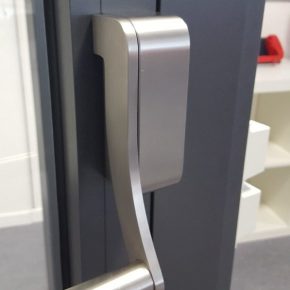
12th April 2024
Strand Hardware: D-Fine Makes a Splash for Seaside Safety
Strand Hardware’s D-Fine range is designed to withstand the harsh conditions prevalent in coastal environments. It is made from 316 stainless steel.
Posted in Access Control & Door Entry Systems, Architectural Ironmongery, Articles, Building Industry News, Building Products & Structures, Building Services, Doors, Facility Management & Building Services, Health & Safety, Innovations & New Products, Restoration & Refurbishment, Retrofit & Renovation, Security and Fire Protection
12th April 2024
GEZE UK – accredited as a Living Wage company
GEZE UK is delighted to announce that the company has been accredited as a Living Wage Employer. The real Living Wage is the only UK wage rate based on the cost of living.
Posted in Access Control & Door Entry Systems, Architectural Ironmongery, Articles, Building Industry News, Building Products & Structures, Building Services, Doors, Facility Management & Building Services, news, Security and Fire Protection
 Sign up:
Sign up: